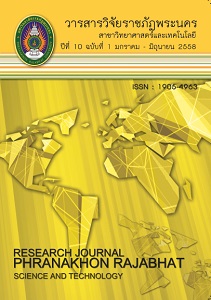โครงสร้างพันธุศาสตร์ประชากรของปลากระบอก (Liza subviridis) ในอ่าวไทย และแนวทางในการอนุรักษ์
Keywords:
ไมโทคอนเดรียลดีเอ็นเอ, คอนโทรล รีเจียน, ประวัติประชากร, ปลากระบอก, mitochondrial DNA, Control region, Demographic history, Greenback MulletAbstract
ศึกษาโครงสร้างพันธุศาสตร์ประชากร และประวัติประชากรของปลากระบอก (Liza subviridis) ในอ่าวไทยโดยวิเคราะห์จาก ความหลากหลายของลำดับนิวคลีโอไทด์ใน ไมโทคอนเดรียบริเวณคอนโทรลรีเจียนเก็บ ตัวอย่างจาก 7 จังหวัด คือ ปัตตานี สงขลา นครศรีธรรมราช เพชรบุรี สมุทรสงคราม ระยอง และตราด จำนวนทั้งหมด 147 ตัว พบว่า มีจำนวนแฮโพลไทป์ทั้งหมด 38 แฮโพลไทป์ ประกอบไปด้วย shared haplotye 13 แฮโพลไทป์ และ rare haplotype 25 แฮโพลไทป์ การที่มีจำนวน rare haplotype จำนวนมาก แสดงว่าประชากรปลากระบอกในอ่าวไทย มีจำนวนเพศเมียที่มีความสามารถในการ ขยายพันธุ์เป็นจำนวนมาก ค่า haplotype diversity และ nucleotide diversity มีค่า 0.779 และ 0.065 ตามลำดับ จากการทดสอบ neutrality test พบว่าค่า Tajima’s D และ Fu’ Fs มีค่า -1.586 และ -10.031 และ มีนัยสำคัญทางสถิติซึ่งเบี่ยงเบนไปจากสมดุล (neutral population) แสดงว่าประชากร ปลากระบอกในอ่าวไทยเคยมีการขยายขนาด มาก่อน โดยจากการทดสอบ mismatch distribution พบว่า ประชากรน่าจะมีการขยาย ขนาดมาประมาณ 100,000 - 10,000 ปี ที่ผ่านมา ในยุคไพลสโตซีนจนถึงยุคโฮโลซีน การทดสอบโครงสร้างพันธุศาสตร์ประชากร ด้วยวิธี AMOVA พบว่าประชากรปลากระบอก ในอ่าวไทยมีโครงสร้างทางพันธุกรรมเกิดขึ้นแต่ไม่มีความแตกต่างของโครงสร้างทาง พันธุกรรมระหว่างประชากรในอ่าวไทยตอนล่าง กับอ่าวไทยตอนบน ผลการศึกษาครั้งนี้สามารถ นำมาใช้เป็นข้อมูลในการจัดการปลากระบอก ในอ่าวไทยได้
POPULATION GENETIC STRUCTURE OF GREENBACK MULLET (Liza subviridis) IN GULF OF THAILAND : IMPLICATION FOR CONSERVATION
Population genetic structure and demographic history of the Greenback Mullet (Liza subviridis) living along the Thailand’s Gulf coast was analysed based on the variation of the nucleotide sequence of mitochondrial DNA control region (mtDNA CR). The mtDNA CR sequences of 147 individual collecting from 7 sampling sites : Pattani, Songkhla, Nakorn Si Thammarat, Petchburi, Samut Songkram, Rayong and Trat province, were analyzed. A total of 38 haplotypes, consisting of 13 shared and 25 rare haplotypes, were identified. An excess of rare haplotypes indicated that the female effective population size of L. subviridis living in the Gulf of Thailand is large. Estimated values of haplotype diversity and nucleotide diversity were 0.779 and 0.065, respectively. The results of neutrality tests, both Tajima’s D and Fu’s FS statistics, yielded negative values (-1.586 and -10.031, respectively) and statistically significant deviation from the neutrality, indicating that the L. subviridis living in the Thailand’s Gulf coast had experienced population expansion. Mismatch distribution analysis indicated that a possible expansion that would occur 100,000 - 10,000 years ago during Pleistocene to Holocene glaciations period. The analysis of molecular variance (AMOVA) showed the genetic structure of the population living in Gulf of Thailand. But genetic structure was not differenced between lower and upper Gulf of Thailand. This study is necessary information contributing to efficient strategies to conserve this species in Gulf of Thailand.
Downloads
Issue
Section
License
โปรดกรอกเอกสารและลงนาม "หนังสือรับรองให้ตีพิมพ์บทความในวารสารวิจัยมหาวิทยาลัยราชภัฏพระนคร สาขาวิทยาศาสตร์และเทคโนโลยี" ก่อนการตีพิมพ์




